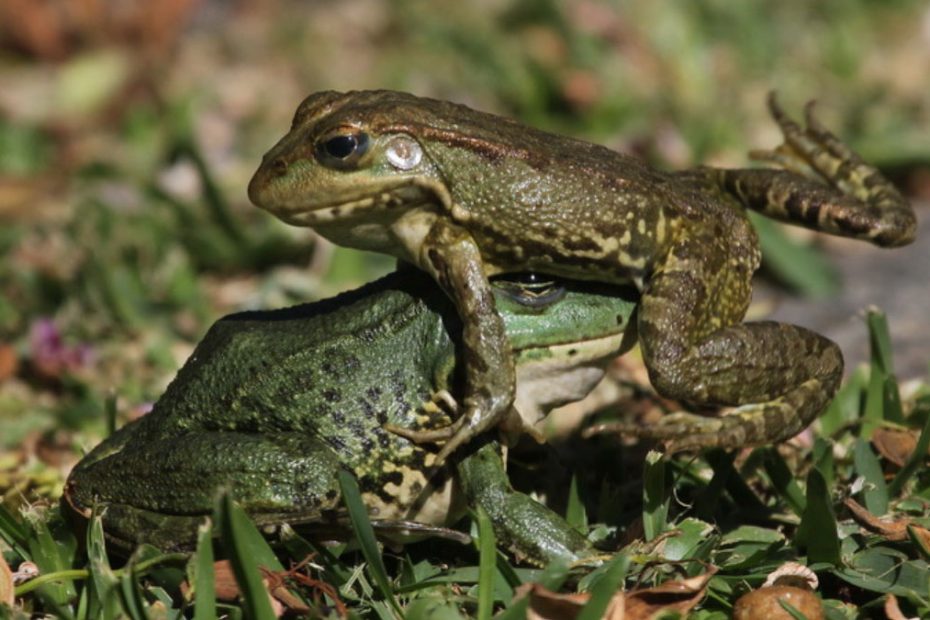Frogs have diverse and fascinating behavior and are known for being voracious predators. Surprisingly one of its shocking traits is its cannibalistic nature.
Do frogs eat each other? Yes, some species of frogs are known to eat a wide range of smaller animals, including their kind. Cannibalism in frogs is more common among adult frogs. Also, some tadpoles consume other tadpoles in the same clutch when there’s food scarcity.
Read on as we discuss more on the cannibalistic nature of frogs, their feeding mechanism, and the reasons why they eat each other. Let’s dive in.
Are Frogs Cannibals: Do Frogs Eat Each Other?
Yes, some species of frogs are known to be cannibalistic, meaning they eat each other. Cannibalism in frogs is more common among adult frogs or those with aggressive feeding behaviors. It can occur in various stages of a frog’s life, including tadpoles consuming other tadpoles in the same ecosystem.
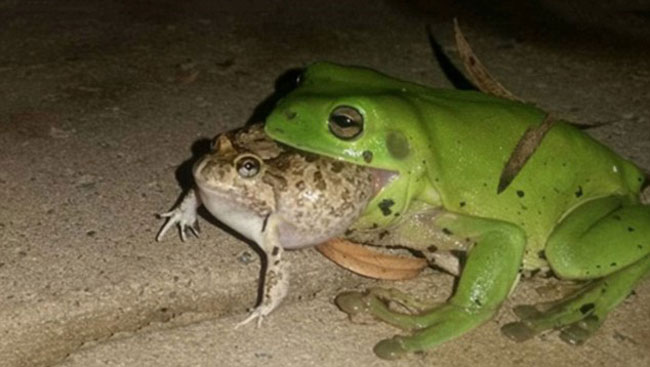
However, while cannibalism is widespread among frogs, it is not a regular occurrence in all frog species. It does occur in certain circumstances.
The instances in which frog cannibalism occurs are:
Tadpole Cannibalism
During resource scarcity or in an overcrowded ecosystem, tadpoles most likely resort to cannibalism for survival. This behavior involves the consumption of eggs or larvae of their species.
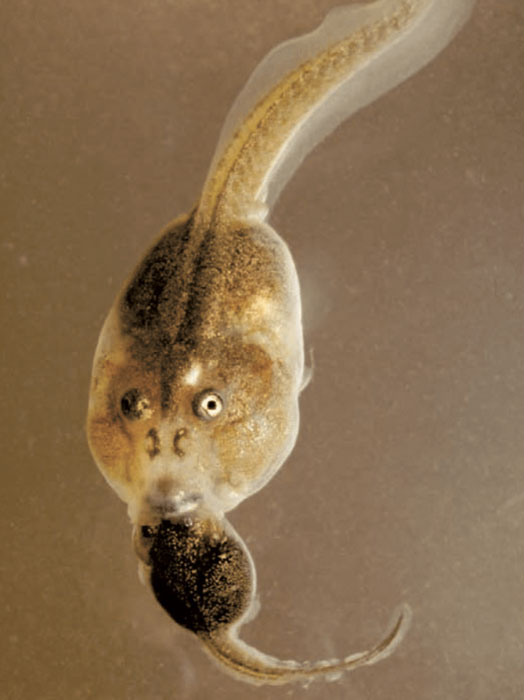
Tadpole cannibalism is an adaptive strategy to cope with limited food availability and reduce competition within their habitat. Research shows this behavior offers nutritionally beneficial options, as consuming conspecific meat provides vitamins and nutrients suited to their physiological needs.
African clawed frogs have been observed eating their tadpoles and those of other species. Studies indicate they will consume their own young, but they like eating the tadpoles of an endangered South African frog much more.
Adult Cannibalism
Adult cannibalism has been observed in certain frog species. Larger frogs will prey on smaller frogs of their species, mainly when resources are scarce. Male poison frogs turn into cannibals after seizing control of areas.
Understanding Frog Feeding Habits
Frogs are primarily carnivorous, so they rely on a diet mainly of small creatures. Here are the feeding habits depending on their species and life stage
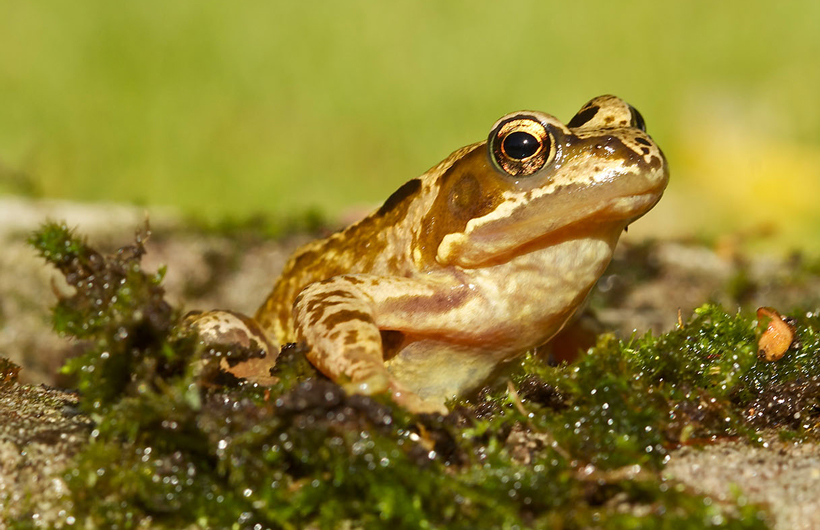
Adult Frogs
Adult frogs primarily have a carnivorous diet, consuming various small animals such as insects (flies, mosquitoes, moths, dragonflies, grasshoppers) and worms. They catch their prey using their long, adhesive tongues. Larger frog species may also eat small snakes, baby turtles, mice, and other frogs.
Tadpoles
Tadpoles, the immature stage of frogs, have different diets based on the species. They can be herbivorous or omnivorous, consuming algae, detritus, plant matter, redworms, and mosquito larvae as typical food sources.
Pet Frogs
The nutritional requirements of pet frogs can vary compared to their wild counterparts. Adult pet frogs commonly receive a diverse diet consisting of live insects, including crickets, hornworms, mealworms, flightless fruit flies, and waxworms.
List of Common Species of Frogs That Eat Other Frogs
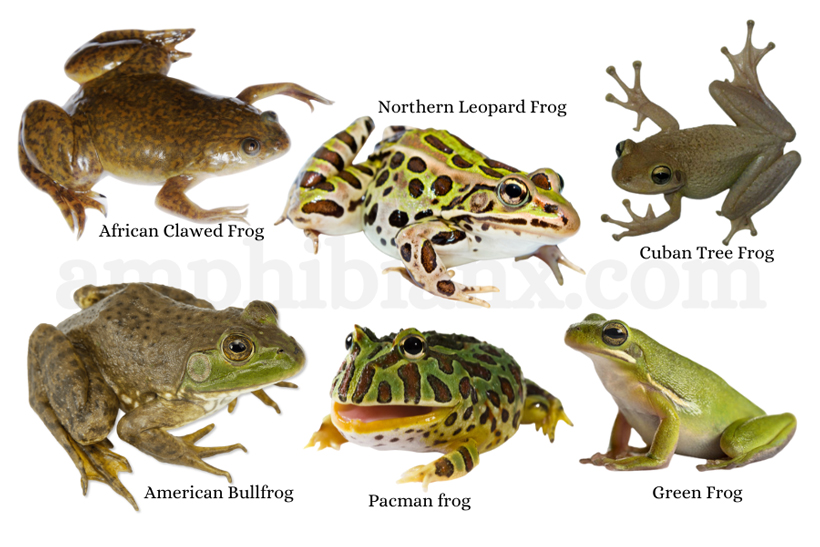
- American Bullfrog (Lithobates catesbeianus): Bullfrogs are large and opportunistic predators known to consume smaller frogs, including their own species.
- Green Frog (Lithobates clamitans): Green frogs have been observed to eat smaller individuals of their own species or other frogs if the opportunity arises.
- Northern Leopard Frog (Lithobates pipiens): Leopard frogs can exhibit cannibalistic behavior, especially in captivity or when resources are scarce.
- African Clawed Frog (Xenopus laevis): In captivity, African Clawed Frogs may display cannibalism, especially if they are overcrowded or lack sufficient food.
- Cuban Tree Frog (Osteopilus septentrionalis): An invasive species in some regions, Cuban Tree Frogs are known to prey on smaller frogs and other small vertebrates.
- Pacman frog (Ceratophrys), or horned frog: is a sizable terrestrial amphibian with a carnivorous diet, which includes other frogs, small mammals, and reptiles.
What Factors Influence Frog Feeding Preferences?
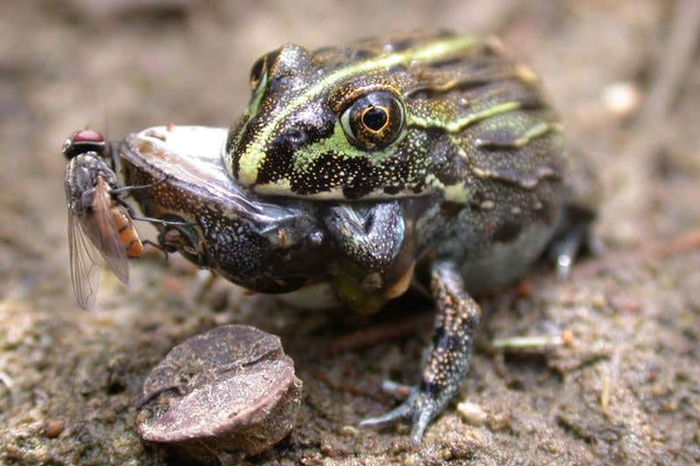
Frog feeding preferences can be influenced by a range of factors, which can differ based on the species and ecological conditions. Here are several aspects that have been observed to shape their dietary choices.
Prey Availability
Frogs will consume whatever food sources are most abundant and accessible. If a particular type of prey becomes scarce or unavailable, frogs will adjust their feeding behaviors accordingly.
For instance, prey availability was found to have a greater impact on the diet of Rana nigromaculata than the selective preference for certain types of prey.
Habitat and Environment
The specific habitat in which a frog resides greatly influences its available food sources. Wetland frogs have access to a variety of aquatic insects while forest-dwelling frogs prey on insects in vegetation or on the forest floor.
Frogs adapt their diet to the food sources available in their environment.
Presence Of Chemical Defenses
Prey with chemical defenses influences frog feeding preferences, particularly in Poison frogs. Research suggests that high alkaloid content in prey can affect dietary choices, with frogs avoiding toxic or alkaloid-rich prey.
Invasiveness
The dietary patterns of invasive frog species reveal a higher consumption of anurans (frogs) compared to native counterparts. This observation suggests that the invasive nature of these species can impact their feeding preferences.
Specialization of Diets
Certain frogs can vary significantly by species, reflecting their unique adaptations and ecological niches, displaying a preference for specific prey types. For instance, certain poison frogs are known to specialize in feeding on ants and mites.
Nonetheless, it’s essential to recognize that even within specialized species, preferences can vary.
Here is a table showing a few frog species and their prey.
| Frog Species | Typical Prey | Specializations |
|---|---|---|
| Poison Frog | Ants, mites, small insects | Ant specialization |
| Tree Frog | Insects, spiders | Arboreal specialists |
| Bullfrog | Insects, small vertebrates | Generalist diet |
| Fire-bellied Toad | Beetles, slugs, worms | Terrestrial specialists |
| Leopard Frog and African Clawed Frog | Insects, small fish | Aquatic Specialists |
What Are The Reasons Behind Frog Cannibalism?

Frog cannibalism can occur due to several reasons, which are influenced by factors such as:
- Limited food availability or competition for resources can lead to frog cannibalism.
- Overpopulation or high frog density in a particular area can increase cannibalistic behavior.
- Cannibalism can be observed in tadpoles or juvenile frogs when they encounter smaller or weaker individuals.
- Larger and more aggressive individuals may prey on smaller or injured frogs.
- Cannibalism can serve as a survival strategy when alternative food sources are scarce.
- Lack of suitable breeding sites or territory can lead to increased aggression and cannibalism among frogs.
- Cannibalism can also occur during the metamorphosis process, as tadpoles undergo rapid physical changes and may exhibit predatory behavior toward each other.
What’s The Impact of Cannibalism?

Here are some key effects of cannibalism on the frog ecosystem.
Population Regulation
Frog population size is reduced by reducing competition for resources and ensuring the survival of stronger individuals.
Nutritional Benefits
Cannibalistic frogs can obtain additional nutrients and energy from consuming conspecifics, potentially leading to improved growth and reproductive success.
Disease Transmission
When frogs consume infected individuals, it increases the risk of pathogen transmission. This results in the spread of diseases and parasites within frog populations.
Altered Behavior
The behavior of individual frogs influences foraging patterns, territoriality, and social interactions within populations.
Ecosystem Stability
Cannibalism among frogs can affect population dynamics, resource availability, and energy flow within the ecosystem. That is, it potentially influences overall ecosystem stability.
While it’s fascinating to uncover the sometimes surprising dietary habits of frogs, it’s equally vital to grasp their physiological nuances. Have you ever wondered about their temperature regulation? Our article on whether frogs are cold-blooded or warm-blooded offers a comprehensive look into this aspect of their biology. And for those who might be keen on keeping frogs away from specific areas, our guide on frog repellent provides effective methods and insights.FAQs
Let’s check out some commonly asked questions regarding frogs.
Yes, frogs have a unique anatomical feature called a “gullet.” This allows them to open their mouths wide and swallow prey items larger than their heads.
When faced with consuming two frogs, they prioritize devouring the ugliest ones.
No, adult frogs who are cannibals generally don’t eat dead frogs. They prefer live frogs over carrion or dead frogs. But in the case of tadpoles, they can eat dead insects or other dead tadpoles.
Final Words
While cannibalism does occur in frogs, it is not a common behavior but rather a response to specific circumstances. The factors such as limited food availability, resource competition, overcrowding, and environmental stressors result in cannibalism.
Tadpole cannibalism is more common and serves as an adaptive strategy. Understanding their feeding habits and occasional cannibalism helps us appreciate the complexity of their ecosystems and the survival strategies of frogs. However, further research is needed to fully understand the implications of cannibalism in frogs.

Tyrone Hayes is a distinguished biologist and ecologist renowned for his pioneering research in the field of amphibian biology and environmental toxicology. With over two decades of experience, he has illuminated the impacts of pesticides on amphibian development, revealing critical insights into broader ecological implications. Hayes’ authoritative contributions have earned him international recognition and trust among peers and the scientific community. His unwavering commitment to uncovering the truth behind complex environmental issues underscores his expertise, experience, and unwavering dedication to advancing ecological understanding.
